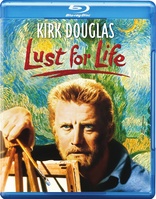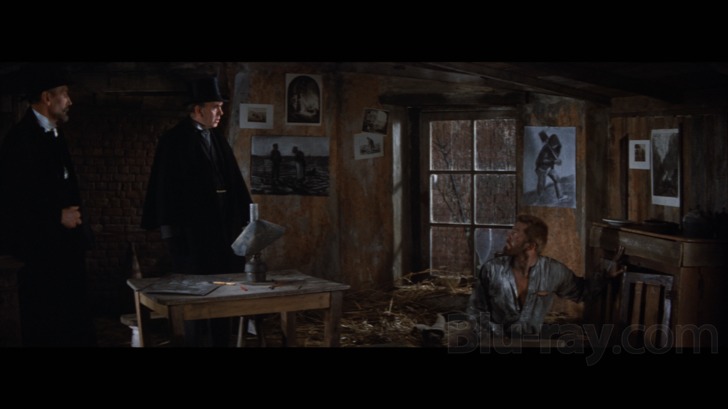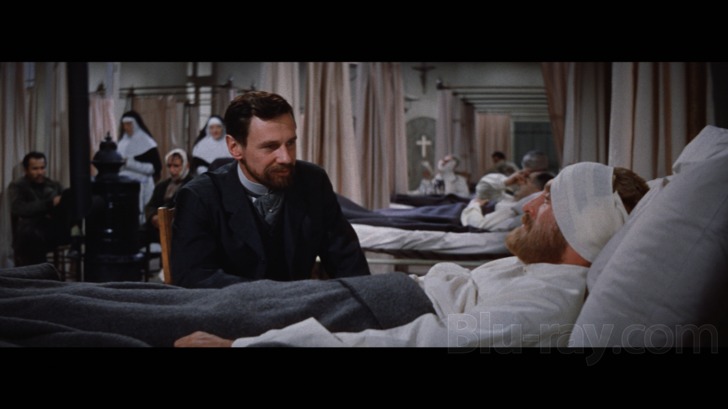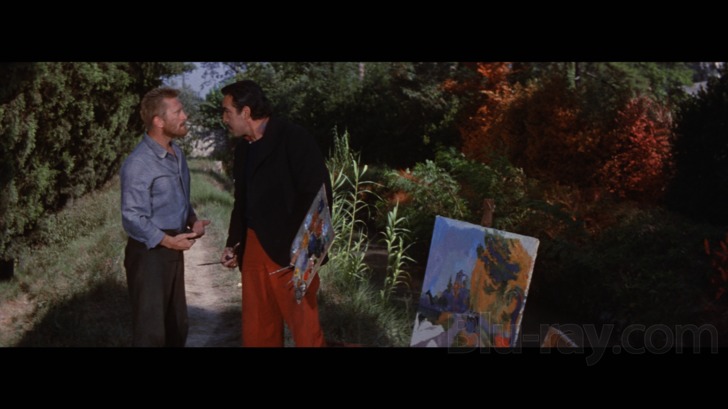Lust for Life Blu-ray Movie
HomeLust for Life Blu-ray Movie 
Warner Bros. | 1956 | 122 min | Not rated | Feb 03, 2015
Movie rating
7.4 | / 10 |
Blu-ray rating
| Users | 4.5 | |
| Reviewer | 4.0 | |
| Overall | 4.2 |
Overview
Lust for Life (1956)
A semi-fictional account of the life of painter Vincent van Gogh, including his many personal struggles as he pursued his unique expression of color and form. Despite the approval of a few fellow artists, notably Paul Gauguin, with whom van Gogh had a famously contentious friendship, only Vincent's brother, Theo, remains steadfast in his support.
Starring: Kirk Douglas, Anthony Quinn, James Donald (I), Pamela Brown, Everett SloaneDirector: Vincente Minnelli, George Cukor
| Drama | Insignificant |
| Biography | Insignificant |
Specifications
Video
Video codec: MPEG-4 AVC
Video resolution: 1080p
Aspect ratio: 2.55:1
Original aspect ratio: 2.55:1
Audio
English: DTS-HD Master Audio 5.1 (48kHz, 24-bit)
French: Dolby Digital Mono
German: Dolby Digital Mono
Spanish: Dolby Digital Mono
Spanish: Dolby Digital Mono (Spain)
Portuguese: Dolby Digital Mono
Subtitles
English SDH, French, Spanish, Portuguese, German SDH, Czech, Dutch
Discs
50GB Blu-ray Disc
Single disc (1 BD)
Playback
Region free
Review
Rating summary
| Movie | 4.0 | |
| Video | 4.5 | |
| Audio | 4.5 | |
| Extras | 3.0 | |
| Overall | 4.0 |
Lust for Life Blu-ray Movie Review
Starry, Stormy Night
Reviewed by Michael Reuben February 7, 2015If Vincent van Gogh hadn't lived, it would be necessary to invent him. The Dutch painter who died poor and unknown in 1890 at the age of 37 has become the patron saint of unappreciated artists and lonely, sensitive souls. Gifted with an eye for color and a style so distinctive that it is immediately recognizable, van Gogh worked himself to exhaustion to develop his technique, but his myth is that of a delicate flower who (in the words of the famous Don McLean song) was too "beautiful" for this world. But the van Gogh mythology wasn't always so ethereal. One of its original architects, Irving Stone, built a much more imposing and stony structure in his fictionalized biography of the painter, Lust for Life, which became a bestseller in the 1930s. MGM's lavish 1956 film adaptation was worshipful, but it didn't airbrush the painter's thorny personality (although it downplayed certain elements of his life, such as homosexuality). Directed by the studio's leading light, Vincente Minnelli, who was himself an aspiring painter, and starring Kirk Douglas, who had long wanted to play van Gogh, whom he believed he resembled, the film was largely shot on location in Europe and used what was then the relatively new format of Cinemascope with its wide aspect ratio that allowed Minnelli to situate van Gogh in the rolling landscapes he liked to paint. The script was by Norman Corwin, a veteran of radio drama, who cracked the puzzle of transforming Stone's massive narrative into a filmable script, after many others (including Stone himself) had failed. It was Corwin who hit upon the device of using Vincent's letters to his brother as a voiceover narration to give the unsociable painter a gentler voice. In an ironic turn, however, the van Gogh estate refused permission to use Vincent's actual letters, so that the painter's innermost thoughts had to be expressed in Corwin's own words.

Lust for Life begins with Vincent as a young man seeking to become a Christian missionary. It's an effective dramatic choice, because it quickly establishes essential elements that recur throughout Vincent's life: his urgent sense of a higher calling; the resistance of official institutions (the church elders find him unfit, because his sermons are lackluster); and Vincent's persistence. He urges the authorities to send him to a posting that no one else wants, and they oblige by dispatching him to the coal mining region of Borinage in Belgium, where life is so hard and hopeless that no one cares about God's word. Determined to make an impression, Vincent begins living like the miners, giving away everything he has. When the elders visit to check on his progress, they are appalled at his ragged clothing and accuse him of undermining the church's dignity. It's the first of many times that Vincent will insist on going his own way. Also, as a pastime, he has begun sketching the miners and their families. This pattern of Vincent hurling himself directly at a challenge, only to suffer rejection and incomprehension, repeats itself throughout his life. (In a phrase that has acquired new resonance for an audience familiar with internet forums, a frustrated Vincent repeatedly complains that he is "only expressing my opinion".) At his parents' home in the country, he abruptly declares his love (and proposes marriage) to his widowed cousin Kay (Jeanette Sterke), who is stunned—and repulsed. At his parents' urging, he goes to The Hague to seek instruction from his cousin, Anton Mauve (Noel Purcell), a professional painter, who fobs him off with boxes of paints and brushes. Even the laundress-turned-prostitute, Christine (Pamela Brown), who lives with Vincent for a time so that he can support her and her child, eventually rejects him, because she gets bored taking care of him—and she can't stand taking second place to his painting. Vincent's most famous adversarial friendship is with another painter, the equally opinionated Paul Gauguin (Anthony Quinn, who won a Best Supporting Actor Oscar for his performance). The two share a house in the French town of Arles, and for a time van Gogh is delighted to have the company of another artist who can appreciate his work. But the two men are of such different temperaments, and they approach painting so differently, that conflict is inevitable. When their arguments become too much for Gauguin, he moves out, triggering the famous incident in which Vincent slices off his own ear with a razor. Besides the physical injury, Vincent suffers a mental breakdown from which he never fully recovers. Throughout Vincent's life, the only relationship that endures is the bond with his brother, Theo (James Donald, who is best known for his trio of POW films, The Bridge on the River Kwai, The Great Escape and King Rat). It is Theo alone who is steadfast in his belief that his older brother has something special to offer the world. It is Theo, an art dealer in Paris, who encourages Vincent to come to the City of Lights, where he introduces him to the work of the Impressionists and to painters like Pissarro (David Leonard) and Seurat (David Bond), who are conducting bold experiments with color. It is Theo who supports Vincent financially and keeps trying to sell his paintings, even when the owner of Theo's gallery disapproves. And it is Theo to whom Vincent pours out his inner feelings in letters and to whom he utters his dying words after lingering for several days following his suicide attempt in a field near the town of Auvers-sur-Oise. (Lust for Life explicitly depicts van Gogh's death as a suicide; a pair of academics have recently theorized that he was murdered, but the theory has not persuaded other experts.) Kirk Douglas' incarnation of van Gogh is an interesting study in an actor overcoming his limitations. Douglas' voice and speech patterns are so distinctively American that one could never mistake them for those of a European artist from the 19th Century. Instead of trying to modulate his speech (something that may have been beyond his ability), Douglas makes van Gogh a presence. His performance is more about how Vincent appears and moves than about what he says or how he sounds. In his posture, in his every movement, even in his rare moments of stillness, Douglas expresses Vincent's discomfort, his awkwardness and uncertainty, his sense of not knowing where he belongs or how to fit in among the people around him. Only when Vincent begins mastering his craft as a painter does Douglas shows him taut, focused and purposeful, working with a fury as if time were running out (which, as it turns out, it was). One of the most interesting choices made by Minnelli was to have Vincent's letters read in voiceover by James Donald's Theo, rather than Douglas' Vincent. In part, this provides balance to the portrayal of the relationship, because Theo has much less screen time than Vincent, even though the brothers are never far from each other's thoughts. But Donald's classically trained British delivery (Donald himself was a Scotsman) confers a dignity on Vincent's innermost reflections that Douglas' voice could not have supplied. Much as the real Theo acted as his brother's representative both before and after his death, the voice of the fictional Theo becomes his brother's intermediary to the viewer of Lust for Life, translating Vincent's unruly emotions into something more appealing to the ear. As the film progresses, Donald's narration becomes as much a part of Vincent's portrayal as Douglas' performance. Some characters are so contradictory that it takes two actors to play them.
Lust for Life Blu-ray Movie, Video Quality 

Two eminent cinematographers are credited on Lust for Life, Russell Harlan (The Great Race) and Freddie Young (Lawrence of Arabia). The film used what was then a brand-new process dubbed Metrocolor, which replaced three-strip Technicolor with a single three-layer strip. (As Dr. Drew Casper explains in his commentary, the process was originally known as "AnscoColor".) It has been reported that a new 4k scan of the original camera negative was the source for this 1080p, AVC-encoded Blu-ray. The results are impressive, faithfully reproducing the elaborate color schemes employed by Minnelli to mark specific periods of van Gogh's life, using his art from each period as a reference. Within the limits of the film technology of the era, the detail in faces, clothing and landscapes is exceptional, marred only by the distortion inherent in the early Cinemascope lenses; this is most visible if one looks to the extreme left and right of the frame during pans. The film's grain structure is fine and natural, and the black levels are excellent (van Gogh's visit to the coal mines is a good example). Lust for Life has been authored for Blu-ray with a high (for Warner Home Video) average bitrate of 27.93 Mbps. Especially with the large letterbox bars, this is sufficient bandwidth for this film, even with its large crowd scenes.
Lust for Life Blu-ray Movie, Audio Quality 

Lust for Life was released in both mono and four-track stereo. I suspect the latter was used as the basis for the 5.1 remix included on Blu-ray in lossless DTS-HD MA, because the separations between voices are too clean to be the result of digital trickery performed on a mono track. Characters at the opposite ends of the screen routinely have their voices issuing from the left and right front speakers, with just enough overlap in the center (assuming your system is properly calibrated) to prevent the sound field from falling apart. The track does not have significant rear channel activity except to open up the lush orchestral score by Miklós Rózsa (Ben-Hur). The dynamic range is broad, considering the source, and the track's fidelity is very good, especially in conveying vocal timbre.
Lust for Life Blu-ray Movie, Special Features and Extras 

Warner's 2006 DVD release of Lust for Life contained a commentary and a trailer, which have been ported over to Blu-ray. Although I do not have a copy of the DVD for comparison, the short feature, Van Gogh: Darkness into Light, appears to be a new extra on Blu-ray.
- Commentary with Dr. Drew Casper: A professor of film at USC and the author of Vincente Minnelli and the Film Musical, among other books, Casper is a frequent commentator. (See, e.g., Possessed and White Heat.) This commentary is packed with historical detail about both Minnelli and the production of Lust for Life. Casper's attempts to situate the film within a sociological context characterized by uncertainty about the image of American masculinity are less than convincing, however. That theme has been invoked so often from World War II to the present that its utility as an explanatory framework has worn thin.
- Van Gogh: Darkness into Light (1080p; 1.78:1; 20:23): MGM produced this 1956 promotional short, narrated by Dore Shary, to spotlight the European locations used for the film.
- Trailer (480i; 2.55:1, enhanced; 3:04): "Few people know the real story of this intense, strong-willed man." They won't necessarily know the "real" story after watching Lust for Life either, but that doesn't reduce the film's values as entertainment.
Lust for Life Blu-ray Movie, Overall Score and Recommendation 

As Dr. Casper notes in his commentary, Lust for Life departs from the usual bio-pic formula, because its subject never triumphed while he was alive. He shoots himself in despair and dies without ever receiving the world's acclaim as one of the greatest painters of the modern era. But Minnelli begins and ends the film with title cards proclaiming van Gogh's greatness and listing the many museums and private collectors who made the artist's works available for inclusion in the film. It's an impressive list, and by bookending Lust for Life with this display, Minnelli effectively supplies the triumph that was missing from van Gogh's actual life. With this device, Minnelli's film makes its own small contribution to the van Gogh mythology, notwithstanding Kirk Douglas' (and James Donald's) masterly incarnation of the difficult (and possibly mad) individual, whose illness and driving ambition made him hell to live with. Warner's Blu-ray is one of its better catalog efforts and is highly recommended.
Similar titles
Similar titles you might also like

Madame Curie
Warner Archive Collection
1943

At Eternity's Gate
2018

I Want to Live!
Limited Edition to 3000
1958

Papillon
2017

Woman Times Seven
1967

Freud
Freud: The Secret Passion
1962

French Postcards
1979

The Revolt of Mamie Stover
Limited Edition to 3000
1956

Save the Tiger
1973

The Man Who Watched Trains Go By
The Paris Express
1952

Rain
90th Anniversary
1932

Connecting Rooms
1970

Anna Lucasta
1958

Advise & Consent
1962

The Wild One
1953

Saint Laurent
2014

Elmer Gantry
1960

Scarlet Street 4K
1945

La Bęte Humaine
1938

Outrage
1950